|
|
|
|
|
|
... from the stories written by my great-grandfather Franco on the Great War:
"I spent long periods in the trenches a few tens of meters from the enemy, among the dead, mud, dung, mice and any other filth, under the launch of hand grenades, night and day, with night patrol services in the intervals between the two trenches that did not exceed three hundred, four hundred meters. Death touched me every day and several times a day. How much luck to whom did I owe it? I took part in many actions, many fights and I always found myself among the mountains of the dead, crowds of wounded survivors of semi-destroyed wards. I took part in the battle of Kuk and Vodige (May 1917), that of Bainsizza (August 1917) and that of Caporetto on the Tolmin front (October 1917), always in the same situation, never touched by a bullet or a splinter, between the raging bombings. Only I did not escape serious illnesses because of that filth and those lice that tormented me, even the Austrians! Yes, because there were two types: our white, yellow, fat and turgid, the Austrian ones smaller and red and as hungry as they are and who attacked us after the fighting in which we occupied their positions ... "
|
|
|
|
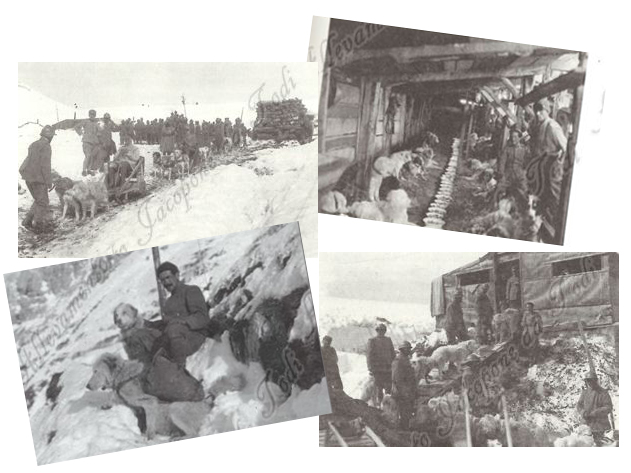
|
Since I was a little boy, when my great-grandfather came to visit us on Fridays, I have listened to war stories, from the battle of Bezzecca in 1866 fought by his father to the Second World War fought by his son ... my dear Grandfather Franco ... we gathered around his chair to listen to him fascinated and incredulous.
I learned to understand how the harshness and atrocities of wars were not so much about kings, emperors, politicians and rulers; it was the infantrymen, the Alpini and the Bersaglieri, opposed to other enemy men, very often also young boys, who endured and fought a war decided by others.
I had the opportunity to investigate events already partially known, but also to discover new topics regarding the sacrifice of animals in the First World War, such as the enormous organizational structure that the Royal Military Veterinary Office had put in place to make the most of the contribution provided by various animal species, from pigeons to horses, from cattle to sheep, from pigs to other working and companion animals such as dogs.
|
|
|
|
|
The Army Veterinary Corps was formed on June 27, 1861 when, the day after the unification of Italy, all the military veterinarians of the various pre-unification armies were brought together under a single command. In those days traction was almost always only animals, however even during the First World War, when the use of mechanical means began to spread, the use of animals was of enormous importance.
The main tasks of the Military Veterinary were fundamentally assistance to the health of quadrupeds, with particular attention to hygiene and prevention rules against diseases that could spread among animals and those transmissible from animals to humans (the main ones were sarcotypal mange, glanders and tetanus ). Furthermore, the logistics of foodstuffs of animal origin with the relative sanitary control of food was already an important task for veterinarians at that time.
Surgery carried out on horses and mules during the Great War amounted to about 600 thousand and posts were organized. medication and first aid near the main war fronts. Convalescentiaries of the Blue Cross were also established (the equivalent of the Red Cross, but destined to rescue animals) with a number of hospitalized patients that was around 260 thousand injured quadrupeds.
From 1915 to 1918 the cattle requisitioned for rationing purposes were two million and 700 thousand, all subjected, before slaughter, to sanitary surveillance.
The use of the military veterinarian was widespread and multifaceted; in times of war emergency, if necessary, the collaboration of "civilian" veterinarians was also used, however, causing disservices and negative consequences for "civilian" animals.
It was therefore a vast and technically very advanced work, which was a model for the future National Veterinary Service
Among the animals that were actively and faithfully close to the soldier in war, the Dog deserves a special memory. Man's best friend was used as a fighting companion by the Persians, the Greeks and the Cimbri and in the Great War he covered an infinite series of roles: they adapted themselves to be "runners", to look for survivors among the dead, to carry out explorations at night and constantly watching over the trenches. They pulled sleds and small carts and in many cases they played the role of companion animals - so widespread today - thus completing their generous role by providing comfort and small moments of joy in that terrible period.
Animals, therefore, all important for one or for the other purpose, often silent and innocent heroes who have also faced and endured immense sacrifices.
Today, animals are more protected than what happened in the past and their protection and safeguarding is guaranteed by laws specifically designed to this end. However, there are cases in which unfortunately this does not happen and this dishonors us as human beings. I refer to certain conditions of stress and suffering in which farm animals live, of course not always and not everywhere, such as chickens, hens, turkeys, rabbits, pigs, cattle and other species, in a vain attempt to reduce costs: I said "vain" because from these "unhappy" animals, among other things, only meat and products that are otherwise poor are obtained.
|
|
|
|
|
|
|
|
THE FIRST WORLD CONFLICT: CHRONOLOGY OF EVENTS
|
|
|
|
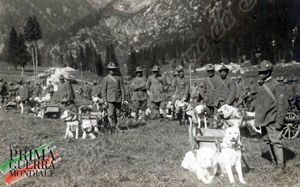
|
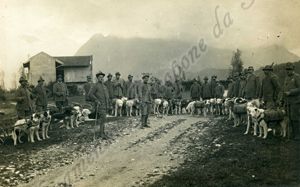
|
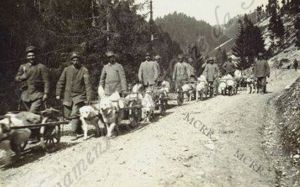
|
|
|
|
Europe at the beginning of the twentieth century was divided into two opposing blocks of alliances between countries. On the one hand, the Triple Entente, with France, England and Russia; on the other, the Triple Alliance, with the Central Empires (Germany and Austria-Hungary) and Italy. Outside the continent, the United States was emerging to the role of world power.
The relations between the European sides, intent on maintaining a state of equilibrium on the continent, had risked degenerating on several occasions and triggering war: nationalisms and the ancient disputes, the race for colonial possessions in Africa and above all the decline of the Ottoman Empire, which led to a dangerous power vacuum in the Balkans, fueled the aspirations of hegemony of Serbia, supported in this policy by the Russian Empire which thus he was opposed to the Balkan policy of Austria-Hungary.
On June 28, 1914 in Sarajevo, in Bosnia-Herzegovina, the heir to the throne of Austria-Hungary Francesco Ferdinando and his wife were assassinated by the pan-Slavist Gavrilo Princip . Behind the attack, the plots of Serbia and Russia were evident.
The events precipitated in a few weeks: Austria-Hungary, in relation to the tragic attack in Sarajevo, sent an ultimatum to Serbia, whose contents dictated very heavy conditions and humiliating, harbinger of an inevitable Balkan conflict.
On July 28, the conditions of the ultimatum, rejected by Serbia, determined the declaration of war and the respective mobilization of armies: the effect of the alliances between the States of Europe dragged in the conflict the latter within a few days. On July 30, the Tsar of Russia, intervening in support of Serbia, declared general mobilization against the Danubian monarchy, the day after Austria did against Russia and on August 1 France and Germany followed. The latter declared war on Russia on the same day and on 3 August on France, crossing the borders of Belgium in the night. England, seeing its own interests threatened, entered the war against Germany.
The Austro-Hungarians began the war by fighting on two distinct fronts: the Balkan one against the Serbian army and the eastern one against the Russian army. In both, the Austro-Hungarians' unpreparedness for war led to military failures and the loss of large troops. The losses (fallen, missing, wounded and prisoners) after five months of war were staggering for both armies: nearly a million men for the Austro-Hungarians, over a million for the Russians.
|
|
|
|
|
|
|
|
ITALY IN WAR
|
|
|
|
|
|
|
|
|
The declaration of neutrality expressed by Italy at the outbreak of the world conflict reinforced the suspicions among the Austro-Hungarians of its imminent entry into the war against the Central Powers. During the first months of 1915 they tried, also through diplomatic channels, to avert the entry of the Savoy monarchy into the conflict. In fact, in Italy the ruling class was holding talks with both warring camps, playing upwards to obtain, in case of support, the greatest territorial compensation. The population, on the other hand, was almost entirely neutral, with interventionists in a clear minority.
|
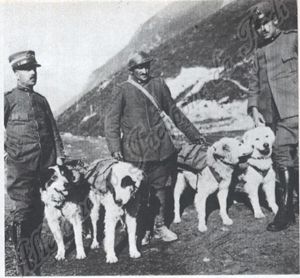
|
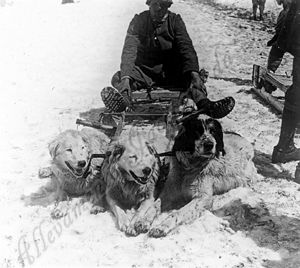
|
|
|
|
|
On April 26, 1915, in London, Italy concluded its negotiations to enter the war alongside the Entente powers. The agreement promised the Sabaudian monarchy the Tyrol up to the Brenner Pass, Gorizia, Trieste, Istria and parts of Dalmatia and other colonial compensations. The agreements that linked Italy to Germany and Austria-Hungary in the Triple Alliance, in fact, obliged it to intervene alongside them only in case of aggression by the allies, but it was the latter who opened the hostilities and the Salandra government exploited this condition. With the signing of the Treaty of London, Italy remained formally allied with both warring camps for a week, then on May 3 it canceled the Triple Alliance pact and on May 24 it declared war on Austria-Hungary. “Southern front”, the Italians concentrated their efforts along the Isonzo river, but without obtaining any results, despite four bloody battles. Along the Tyrolean salient the Italian army had only approached the Hapsburg line of resistance, without affecting it at any point.
With the arrival of spring 1916, the war took steady footing also on the alpine glaciers (first of all that of the Adamello) and the Austro-Hungarians, contained the initiative of the Italians, unleashed the "spring offensive" (also known as strafexpedition) planned for some time on May 15. The plan was to descend from the plateaus into the Venetian plain and thus cut off all supply routes to the bulk of the Italian army, engaged on the Isonzo, forcing it to surrender. The offensive of the highlands moved the front for about ten kilometers into the Italian territory, but did not achieve the result desired by the Austro-Hungarians. It also deprived the eastern front of means, which suffered the offensive of the Russian army and finally gave Romania the opportunity to enter the conflict and declare war on the Hapsburg Empire, seeing it in a moment of serious difficulty.
On the front the Italian army, forced to retreat to the highlands, resumed the initiative both on the Isonzo and along the Tyrolean salient, but the sixth, seventh, eighth and ninth battles of the Isonzo had the only significant result conquest of Gorizia, costing a very heavy toll of human losses: 300,000 men!
|
|
|
|

|
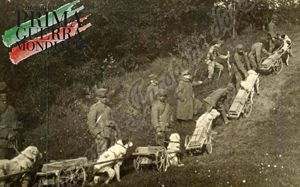
|
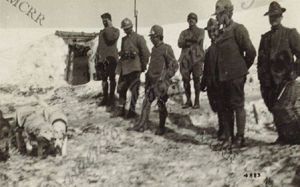
|
|
|
|
Between 1916 and 1917 spontaneous and unauthorized demonstrations against the war spread throughout the country, proving once again that Italy's intervention was wanted and piloted by a small oligarchy. Fatigue among the soldiers, economic hardship, shortage and rationing of primary food goods, discontent with the progress of the war resulted in real strikes in 1917, despite the war legislation being in force.
La terrible 10th battle of the Isonzo, between May and June 1917, and the subsequent battle of the Ortigara produced enormous voids in the ranks of the Italian army (respectively 160,000 men on the Isonzo and 23,000 on the Ortigara) and in the enemy one, without any significant change of the front. It was the 11th battle of the Isonzo, between 17 and 31 August, that seriously undermined the defensive system of the Austro-Hungarian army, forcing it to request the help of its German ally to resolve its situation. Between 27 October and 12 November the armies of the Central Powers opened the 12th battle of the Isonzo, better known as the Caporetto offensive, which cost the Italians the loss of more than 300,000 men including dead, wounded and prisoners and moved the war front on the Monte Grappa-Piave line.
Caporetto was a ridge for the Italian society, which from an offensive war found itself having to face a defensive one in its own territory. The Austro-Hungarian army was able, with the occupation of Friuli and Upper Veneto, to feed its troops for a few weeks, but by now the economic situation of the Habsburg Empire had become desperate. Just to get out of a stalemate of months, in June 1918 the Austro-Hungarian army attempted a final offensive on the Piave, with secondary operations both on the Tonale and on the plateaus. The failure of this great battle, which the war industry was no longer able to support, led to the collapse of Austria-Hungary. The allies of the Habsburg Empire also suffered the same fate.
General Diaz, who succeeded Cadorna in the aftermath of Caporetto, preferred to take time in the face of the insistent requests of the allies, before organizing a decisive offensive. In the autumn, however, when the difficulties of the Austro-Hungarian Empire were evident, an Italian action became unpostponable and the Commander, also spurred on by the Orlando government, prepared the offensive across the Piave, towards Vittorio Veneto, which began on 24 October.
Throughout the month of October Germany, despite being aware of having lost the war, refused to accept the surrender it accepted only in the face of the collapse of the country. On the other hand, the Austro-Hungarian Empire had repeatedly tried, despite the German protests, to approach the exponents of the Entente Powers to achieve peace.
|
|
|
|
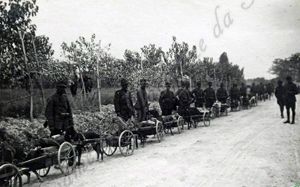
|

|
On the morning of 29 October in Vallagarina, the Captain of the Habsburg General Staff Camillo Ruggera, appointed by General Von Weber, went with a white flag towards the Italian lines, to undertake contacts and to initiate armistice negotiations. The following night, with the Habsburg army in full disintegration, the Italians built bridges over the Piave. The day after the Savoy army came down from Grappa and reached Feltre and Vittorio Veneto. On October 31, the Supreme Command of the Italian army gave the order to advance suddenly, noting the retreat on the whole front by the opponent. Only that day was the Habsburg armistice commission taken to the place of negotiations, namely Villa Giusti near Padua. On 1 November the Italian Supreme Command in Abano received the first armistice conditions from Paris and sent some representatives to Villa Giusti, including General Pietro Badoglio, head of the Italian Armistice Commission and an interpreter, Giovanbattista Trener, brother-in-law of Cesare Baptists.
|
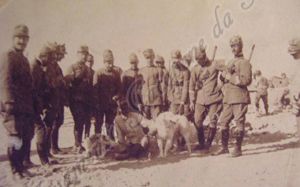
|
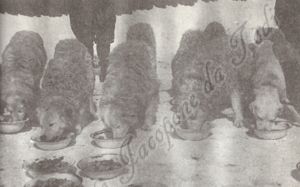
|
|
|
|
|
Despite pressure from Austrian representatives, the members of the Italian Commission opposed the request to cease hostilities before the armistice was signed. The armistice was signed at 3 pm on November 3, while the Italian troops were reaching Trento and Trieste, but hostilities ceased at 3 pm the following day. On November 4, Diaz issued the "Victory Bulletin". In the Tyrol, the Italian army had reached the Sluderno, Spondinga, Malè, Cles, Mendola, Salorno, Monte Panarotta, Valsugana, Corno di Tesino and Fiera di Primiero lines. In the following days the Italians reached the Dobbiaco countryside and on 11 November they were at Brenner. In that race to acquire territories, the Italians made thousands of prisoners who, in the conviction of the armistice, retreated from their positions garrisoned for three long years. The number of prisoners of war detained in fact went from about 180,000 on 24 October 1918 to over 470,000.
Thus ended the First World War, which cost Italy 650,000 dead, 10% of the men enlisted. The following year peace treaties were drawn up, including, on 10 September, that of Saint-Germain on relations between Italy and Austria, which determined the new borders between the two states.
|
|
|
|
|
|
|
|
SOLDIER ANIMALS
|
|
|
|
|
|
|
|
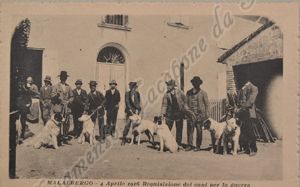
|
The First World War was a war different from all those fought up to then, in many respects. More than previous conflicts, it marked a dividing line in the so-called "art of war" and in the conduct of military operations, but it was also a meeting point between the emerging technological world and the rural one. More and more deadly weapons (toxic gases, flamethrowers), planes and tanks made their appearance, in a context that saw motor vehicles plow the same roads that had been traveled up to then by carts pulled by animals. A body such as the cavalry, which with its powerful charges had distinguished the wars of most of the nineteenth century, made its final disappearance: still used in 1914 only for observational reconnaissance purposes, it was practically footed and its regiments compared to those of infantry.
Animals, however, played an increasingly fundamental role as the months of war passed: they were in fact incorporated into the so-called "train", that is the military apparatus that moved all the logistical operations of the armies: field kitchens , transport of food, casualties, ammunition, armaments, etc.
|
|
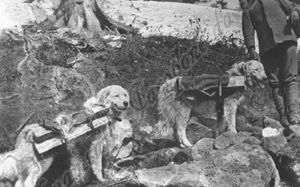
|
|
|
The Italian army alone, which at its entry into the war in 1915 had enrolled 806 quadrupeds to tow 400 wagons, already the following year had over nine thousand animals that pulled about 2,600 wagons and in the last year of the war draft animals about 18,000 were used for almost 6,000 wagons.
The Great War was therefore also a ridge for animals that were “militarized” en masse. In fact, they followed the fate of millions of men: they were enlisted and trained, they received specific tasks, a ration, lodgings and were treated if wounded. Even the use of veterinarians at the front to treat and save animals when possible became fundamental, considering that any increase in quadrupeds requested by the army weighed on the already critical conditions of the internal economy of the various countries.
The Austro army -Hungarian for years had made its "animal park" available to the agricultural economy, but the war caused such haemorrhage of the latter to require the requisition of quadrupeds from the population. Previously, in fact, the pack animals owned by the army were rather often entrusted to private individuals, upon request: the latter had to be available to return the animals within 24 hours in case of mobilization and had to keep them in good health; after six years of maintenance, the animal became their property. With the outbreak of the war, then, the owners of draft animals had to make their beasts available, which in the years immediately preceding the conflict had been registered and reported to the military authorities through the common head; in 1905 the indemnities established by the legislature were 28 cents per horse or mule, 25 per ox, 17 per cow or donkey.
Basically, man could not do without animals: in addition to draft ones, the carrier pigeons connected and brought orders and information to the soldiers, while the dogs took care not only of the transport, but also of the dispatching of dispatches, of the search and identification of the wounded in the field, of the reporting of any dangerous situations.
|
|
|
|
Cani e anche gatti svolsero poi il prezioso ruolo terapeutico di animali da compagnia, in grado di riportare all'umanità soldati che vivevano quotidianamente la follia del conflitto e le sue tragedie. & Lt; br & gt; Per tutti questi motivi risulta praticamente indeterminabile l'esatto numero degli animali che durante la guerra furono impiegati al fronte. Si stimano in circa 16 milioni gli animali “mobilitati”, fra cui 11 milioni di equini, 100.000 cani, 200.000 piccioni viaggiatori. Si calcola che non meno di otto milioni di cavalli, muli e asini morirono nel corso della Grande Guerra.
Ma di tutti la loro storia ufficiale si è occupata poco. A parte alcuni pregevoli lavori, di essi, dei loro sforzi, delle loro sofferenze, di tutto questo si conserva poca traccia. Fanno eccezione le ordinanze e la storia individuale dei singoli soldati, ovvero lettere, corrispondenza, diari. Emblematica, in tal senso, la testimonianza riportata da Attilio Frescura, tenente dell'esercito italiano e scrittore, nel suo “Diario di un imboscato” , una delle poche opere della guerra priva di retorica: “Sono venuti qui tre autocarri di feriti. Una granata, nel tragitto, ha ferito il cagnolino del conducente salvando il ventre del suo padrone, sulle cui ginocchia era accovacciato. Gli autisti sempre un cagnolino per mascotte… il cane, dolorante, ora è accovacciato sulle gambe di un ferito austriaco. E sembra che non se ne dolga. Perché non hanno odi di razza i cani… ”FRESCURA A., Diario di un imboscato, Mursia, Milano, 1981, p. 67.
|
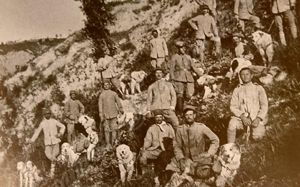
|
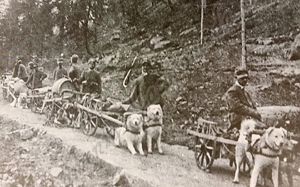
|
|
|
|
|
|
|
|
|
DOGS IN WAR
|
|
|
|
|
|
|
|
The best friend of man shared, at the outbreak of the conflict, the fate of millions of masters.
In the Italian army, where dogs were used since the Libyan war of 1912, the figure of Captain Carlo should be remembered in particular Mazzoli (1879), during the war he became Major on the Carso and Lieutenant Colonel on Adamello. Mazzoli, also known as the "Lieutenant Cagnaro" , was one of the most important dog trainers in the Italian Army. He taught dogs to pull sleds, conducting training directly at the front, even with dogs found abandoned in the pastures involved in various military operations.
The German army was particularly at the forefront in the use of dogs; he employed at least 35,000 specimens, mainly Dobermans and German Shepherds .
In the Austro-Hungarian Empire, the "canine lever" was established as early as 1914 and dog owners had to bring their animals to a visit in which army veterinarians determined whether or not the dog was eligible for military service. Animals that could potentially be used were exempted from the dog tax, which was in force in the Empire. The dogs (kriegshunde) after training could be used for transport services, or to search for wounded on the various battlefields.
In the Italian Army the dogs most used for this use it was the Maremmani Abruzzesi who generally pulled sleds or two-wheeled carts, but also larger ones, for the transport of the wounded and more. Towing could be carried out by one or more pairs of dogs or by three dogs for small carts. Transport could consist of construction materials, firewood but also weapons such as machine guns or small caliber cannons (37 mm).
A more demanding task fell to the health dogs. At the end of the bloody battles, many wounded often lay in no man's land who certainly could not return to their lines or to be recovered by the already busy health departments. The dogs then came out of the trenches carrying a harness with the symbol of the Red Cross and went on a reconnaissance among the craters of the grenades and the uprooted fences in search of the wounded. In case of discovery, the dog re-entered the lines with an object of the injured person and the recovery patrol was activated accordingly.
Given the long commitment that their training involved, it was recommended to the troop departments the utmost care and attention for the animals assigned to them. In case of infectious diseases, the wards were quickly isolated to prevent the spread of the infection. In Giustino, on the Adamello front, in May 1916, rabies was found in an army dog. Prevention and containment measures were immediately put in place, forcing dog owners to keep them on the chain and on a leash with a muzzle. Dogs found roaming free would be killed. It is significant to note that in that period a dog registry was made: in the whole town, which had 430 inhabitants, there were only four small dogs and a Saint Bernard , all the others they had been requisitioned by the army.
Other duties for the dogs in warfare were reporting any enemy assaults and cleaning rat-infested trenches. Generally for these purposes small dogs were used, not used for towing or health. Small dogs were particularly suited to barking at the appearance of the first suspicious noises, thus alerting the lookouts (and not only those) that something was moving in the vicinity of the fences.
|
|
|
|

|
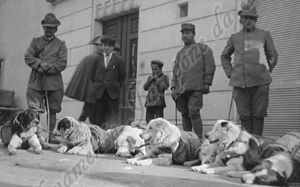
|

|
|
|
|
The last task that man's faithful friend carried out during the war was that of a companion animal. Generally an officer had his own dog, just as a platoon or company of soldiers adopted an animal as their mascot. His was an important role: to restore the soldier to peace with himself, to a "normality" where nothing was ordinary. Soldiers deeply shaken by the horrors of war returned to humanity thanks to the company of their animals, who also followed them to the outposts ...
At the end of the war, after having suffered countless pains and suffered the human madness of that terrible conflict, thousands of war dogs were abandoned to their fate. There were some lucky animals that managed to rejoin their master, others found a new one, but for many there was killing or a stray life; one last terrible punishment that the ungrateful man inflicted on his always faithful, best friend!
|
|
|
|
|
|
|
|
THE ABRUZZESE MAREMANS IN FRONT OF THE ADAMELLO
|
|
|
|
|
|
|
|
Our shepherd dog was widely used in the First World War, as described, for its countless qualities of strength, rusticity and versatility. Since the opening of hostilities, the Italian Army placed a small garrison at high altitude on the Adamello, not far from the Tonale Pass which today divides Lombardy from Trentino, at the Garibaldi refuge, to protect the Brizio and Venerocolo passes. It was in this detachment that our research concentrated on finding numerous photographic and documentary material on the hard work of the Abruzzese Maremmans ... This refuge, in July 1915, was the subject of an attempted Austrian attack, thwarted by Italian soldiers. The assault was a consequence of the attempt, made on the previous June 9, by the Alpine troops of the Morbegno battalion, to force the opposing defenses into the basin of the Presena glacier.
With the continuation of the conflict and the increase in the presence of armed forces on the Adamello massif, the basin of the Garibaldi refuge from a small garrison became the logistic center of the whole sector, with a capacity of shelter of more than a thousand men, heated infirmaries, bathrooms, stables and warehouses. Men, food and supplies of all kinds rose from the valley floor to the refuge; the stocks present were able to cover the needs of the sector for two weeks. From the logistics center, the supply of the advanced lines and outposts located on the glacier had to be guaranteed. Precisely for this service, given the extremely rigid and prohibitive winter temperatures for the survival of mules and horses, they resorted to the transport on sleds pulled by dogs, mostly Maremmani Abruzzesi who, due to their innate skills described above, were tested and used on the 'Adamello starting from the summer of 1916.
Among the dog trainers for the high altitude transport of the Italian army, we remember the charismatic figure of Captain Carlo Mazzoli (Cesena, 1879 - Bengasi, 1928), who resorted to using man's best friend on the front of Val Dogne, in Carnia, noting that the transport with dogs was less visible to the enemy than traditional baggage. He first trained a pack of dogs for pulling sleds with food and ammunition, then this idea was picked up by the Army General Staff who set up a recruitment of sled dogs, which were trained and then assigned to the various alpine departments " cagnari ". Mazzoli was also on the Alpine front in the Ortles-Cevedale and Passo del Tonale group where he arrived in 1917, then the following year he was promoted from Captain to the rank of Lieutenant Colonel and became Commander of the Val d’Orco Alpine Battalion. Here, on the mountains between the Stelvio and the Tonale, he brought the experiences acquired during the previous years with dogs and sleds.
Carlo Mazzoli was the opposite of the traditional army officer: long hair and scruffy beard are the elements badges that jump to the eyes in the main image that has been preserved of him and that inevitably portrays him in the company of his dogs. All this only increased his charisma: it seems that Vittorio Emanuele III also wanted to know him and that he presented himself to the king in the company of his beloved four-legged friends.
|
|
|
|
On the Adamello in the summer of 1918 there were 220 dogs:
"They were a Maremma Abruzzese shepherd breed, requisitioned in the Apennines and trained in the military kennel of Bologna. Coat of maximum white, smooth or curly hair, tall, strong, very intelligent, they immediately showed a marked adaptation and an exceptional resistance to the rigors of the climate. With the well-known sympathy for the soldiers they became fond of their driver (called a cagnaro) each of whom had three dogs in delivery. With simple hitches, three by three, they pulled the sleds with a payload of 130 to 150 kilograms. Almost all of them were located at the “Garibaldi Pass” in a large hut built for kennel use with double walls and raised about a meter above the snow level. They had a ration almost identical to the soldier and fortnightly the captain consignee of the subsistence paid them homage to the butchery waste.
|

|
|
|
|
They began the service at dawn and in principle made two daily trips from the "Garibaldi Pass" to the centers of "Passo Lobbia", "Passo Fargorida" and the "Cavento" cableway (after 1917). Overall they transported between 150 and 200 quintals of cargo per day. The dog service was a characteristic sight. The newly loaded sledges set off. The dogs at the voice of the driver ran down the track marked on the glacier with a festive yelp that sounded like a greeting in the white light of the dawning day. In the flat stretches they moderated their gait to a slight trot, uphill they proceeded to stride forward with their heads down in a continuous effort.
Sometimes they stopped, and to resume their journey together they reared up barking almost to agree effort necessary to take their place again, or they turned to the soldier an eloquent plea for help. If they saw a fellow inactive it was a ferocious bark. The Alpine troops said they barked at ambushes.
In winter, during the storm they were wonderful. The chill covered their whole head, neck, paws with icicles, the sleet lashed their eyes and they with low tails blowing their nostrils, proceeded faithfully forward across the polar landscape. "
(VIAZZI L., The White War on Adamello, II revised and enlarged edition, GB Monauni Publishing House - Trento, 1968, pp. 272-274). < br> The Transport Dog Department of the Royal Italian Army was dissolved on November 3, 1918 and, apparently, the Adamello dogs, in the excitement of those last days of war, were forgotten up there, on the ice. But some of them managed to escape from shelters and were seen wandering at the bottom of the valley, wild, betrayed by man and disappointed by his ungratefulness.
|
|
|
|
Jacopo Simoni
|
|
|
|
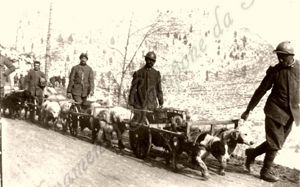
|
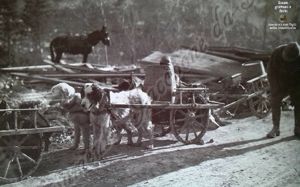
|

|
|
|
|
|
|
|
|
|